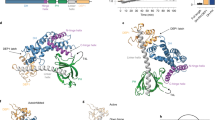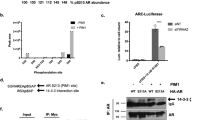Abstract
The protein REPS2 is implicated in growth factor receptor-mediated endocytosis and signalling, and its expression is downregulated in androgen-independent prostate cancer cells. Herein, the NF-κB subunit p65 is identified as a human REPS2 protein partner, interacting with the EH domain of REPS2. Using crystal structure data from literature and experimental data from yeast and mammalian two-hybrid analysis, the results indicate that the NPF-motif in p65 acts as binding site for the EH domain in REPS2. However, in cultured prostate cancer cells, the REPS2–p65 interaction is triggered upon stimulation with phorbol ester (PMA). This indicates that PMA-sensitive signalling pathways can affect the interaction between REPS2 and p65. During prostate cancer progression from androgen-dependent to androgen-independent growth, downregulation of REPS2 is accompanied by upregulation of NF-κB activity. This might involve loss of REPS2–p65 interaction, which would lead to increased NF-κB activity. Androgen-deprivation causes apoptosis of prostate cancer cells, and activated NF-κB is a known inhibitor of apoptosis. Hence, decreased expression of REPS2 might be a key factor, causing prostate cancer cells to become resistant to induction of apoptosis by androgen deprivation.
This is a preview of subscription content, access via your institution
Access options
Subscribe to this journal
Receive 50 print issues and online access
$259.00 per year
only $5.18 per issue
Buy this article
- Purchase on Springer Link
- Instant access to full article PDF
Prices may be subject to local taxes which are calculated during checkout







Similar content being viewed by others
References
Chang GT, Blok LJ, Steenbeek M, Veldscholte J, van Weerden WM, van Steenbrugge GJ and Brinkmann AO . (1997). Cancer Res., 57, 4075–4081.
Chen CD and Sawyers CL . (2002). Mol. Cell. Biol., 22, 2862–2870.
Chen FE, Huang DB, Chen YQ and Ghosh G . (1998). Nature, 391, 410–413.
De Beer T, Carter RE, Lobel-Rice KE, Sorkin A and Overduin M . (1998). Science, 281, 1357–1360.
De Beer T, Hoofnagle AN, Enmon JL, Bowers RC, Yamabhai M, Kay BK and Overduin M . (2000). Nat. Struct. Biol., 11, 1018–1022.
Fazioli F, Minichiello L, Matoskova B, Wong WT and Di Fiore PP . (1993). Mol. Cell. Biol., 13, 5814–5828.
Garg A and Aggarwal BB . (2002). Leukemia, 16, 1053–1068.
Gietz RD and Woods RA . (2002). Methods Enzymol., 350, 87–96.
Hoffman CS and Winston F . (1987). Gene, 57, 267–272.
Huxford T, Huang DB, Malek S and Ghosh G . (1998). Cell, 95, 759–770.
Ikeda M, Ishida O, Hinoi T, Kishida S and Kikuchi A . (1998). J. Biol. Chem., 273, 814–821.
Jacobs MD and Harrison SC . (1998). Cell, 95, 749–758.
Kimura K and Gelmann EP . (2002). Cell Death and differentiation, 9, 972–980.
Ling MT, Wang X, Ouyang XS, Xu K, Tsao SW and Wong YC . (2003). Oncogene, 22, 4498–4508.
Mayo MW, Wang CY, Cogswell PC, Rogers-Graham KS, Lowe SW, Der CJ and Baldwin Jr AS . (1997). Science, 278, 1812–1815.
Nakashima S, Morinaka K, Koyama S, Ikeda M, Kishida M, Okawa K, Iwamatsu A, Kishida S and Kikuchi A . (1999). EMBO J., 18, 3629–3642.
Oosterhoff JK, Penninkhof F, Brinkmann AO, Grootegoed JA and Blok LJ . (2003). Oncogene, 22, 2920–2925.
Palayoor ST, Youmell MY, Calderwood SK, Coleman CN and Price BD . (1999). Oncogene, 18, 7389–7394.
Paoluzi S, Castagnoli L, Lauro I, Salcini AE, Coda L, Fre S, Confalonieri S, Pelicci PG, Di Fiore PP and Cesareni G . (1998). EMBO J., 17, 6541–6550.
Park JL, Lee MG, Cho K, Park BJ, Chae KS, Byun DS, Ryu BK, Park YK and Chi SG . (2003). Oncogene, 22, 4314–4332.
Salcini AE, Confalonieri S, Doria M, Santolini E, Tassi E, Minenkova O, Cesareni G, Pelicci PG and Di Fiore PP . (1997). Genes Dev., 11, 2239–2249.
Santolini E, Salcini AE, Kay BK, Yamabhai M and Di Fiore PP . (1999). Exp. Cell. Res., 253, 186–209.
Steiner H, Godoy-Tundidor S, Rogatsch H, Berger AP, Fuchs D, Comuzzi B, Bartsch G, Hobisch A and Culig Z . (2003). Am. J. Pathol., 162, 655–663.
Sumitomo M, Tachibana M, Nakashima J, Murai M, Miyajima A, Kimura F, Hayakawa M and Nakamura H . (1999). J. Urol., 161, 674–679.
Van Antwerp DJ, Martin SJ, Kafri T, Green DR and Verma IM . (1996). Science, 274, 787–789.
Wang CY, Mayo MW and Baldwin Jr AS . (1996). Science, 274, 784–787.
Wong WT, Schumacher C, Salcini AE, Romano A, Castagnino P, Pelicci PG and Di Fiore P . (1995). Proc. Natl. Acad. Sci. USA, 92, 9530–9534.
Zerbini LF, Wang Y, Cho JY and Libermann TA . (2003). Cancer Res., 63, 2206–2215.
Acknowledgements
We thank Dr HJ Dubbink of the Department of Pathology and Dr GW Jenster of the Department of Urology, Josephine Nefkens Institute, Erasmus MC, Rotterdam, The Netherlands, for collaboration, constructs, comments and discussions. This work was supported by a grant from the Netherlands Organisation for Scientific Research (903-46-169) and by the Erasmus Trust Fund.
Author information
Authors and Affiliations
Corresponding author
Additional information
Supplementary Information accompanies the paper on Oncogene website (http://www.nature.com/onc)
Supplementary information
Rights and permissions
About this article
Cite this article
Penninkhof, F., Grootegoed, J. & Blok, L. Identification of REPS2 as a putative modulator of NF-κB activity in prostate cancer cells. Oncogene 23, 5607–5615 (2004). https://doi.org/10.1038/sj.onc.1207750
Received:
Revised:
Accepted:
Published:
Issue Date:
DOI: https://doi.org/10.1038/sj.onc.1207750
Keywords
This article is cited by
-
Liver X receptor agonists exert antitumor effects against hepatocellular carcinoma via inducing REPS2 expression
Acta Pharmacologica Sinica (2023)
-
Identification a novel set of 6 differential expressed genes in prostate cancer that can potentially predict biochemical recurrence after curative surgery
Clinical and Translational Oncology (2019)
-
Recurrent and novel SS18-SSX fusion transcripts in synovial sarcoma: description of three new cases
Tumor Biology (2012)
-
The central proline rich region of POB1/REPS2 plays a regulatory role in epidermal growth factor receptor endocytosis by binding to 14-3-3 and SH3 domain-containing proteins
BMC Biochemistry (2008)



